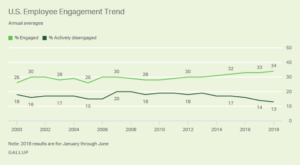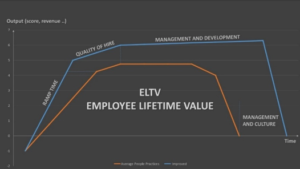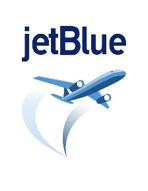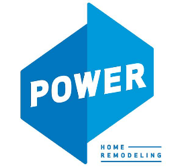Peter Moore reports in Wild Oak:
Most companies can tell you the approximate lifetime value of their core customers. On the other hand, how many companies can tell you the lifetime value of their employees and how enabling their full value has a direct impact on achieving their customers’ lifetime value? 66% of American workers are not fully engaged in their work. Disengaged employees cost U.S. companies between $450-$550 billion a year in lost revenues. Companies that have happier employees show 147% higher earnings per share and 21% higher profitability than their competitors. Your customer experience is an extension of your employee experience.
- 66% of American workers are not fully engaged in their work. (Gallup) see chart below
- Disengaged employees cost U.S. companies between $450-$550 billion a year in lost revenues. (HR Drive)
- 53% of Americans are currently unhappy at work. (The Conference Board)
- 100 unhappy employees cost companies $390,000 per year in lost productivity. (Kansas State University)
- Negative employees scare off customers. (Gallup)
Most companies today can tell you the approximate lifetime value of their core customers. Many have adopted the Net Promoter Score (NPS) and other customer experience/satisfaction measurement tools to track how well they are realizing the full potential of that value.
On the other hand, how many companies can tell you the lifetime value of their most valued employees and how enabling them to realize their full value has a direct impact on achieving their customers’ lifetime value.
Why not create a net promoter score to measure employee engagement? The question to ask is “ how likely are you to recommend that a friend or associate come work for your company?” Armed with the answers to that question, you can start to build a targeted program to move “passives” to “promoters.” The percentage of respondents who are “detractors” will also give you a comparison to the Gallup survey results.
Great employee experience (EX) drives great customer experience (CX)
The new reality is that your customer experience is an extension of your employee experience. Employee experience starts with a company’s commitment to create and sustain an employee-centric culture that enables their growth, development and success. It’s reinforced by multiple studies that document a direct correlation between EX and CX which translate into market leading performance.
- Companies that have happier employees show 147% higher earnings per share and 21% higher profitability than their competitors according to Gallup’s research.
- Companies with great EX outperform the S&P 500 by 122% according to a 2017 Accenture study.
- Companies with highly engaged employees have a 19.2% growth in operating income over 12 months and have 218% higher income per employee according to a study by the Association for Talent Development (ATD).
What it takes to enable employees to be fully engaged and happy
In today’s digital enterprise, the old vertically integrated, hierarchical organizational structures have given way to cross-functional horizontally structured business networks. These new networks require increased demand for communication, coordination and collaboration among peers both internally across the enterprise and externally with customers, supply chain partners and other key constituents.
To carry out these new roles, employees need to be equipped new tools and customized training and development programs backed by a culture that gives them free reign to deploy them. From my perspective, fully engaged and happy employees are a direct result of a culture where they feel respected, trusted and valued.
Companies that treat their employees as assets rather than costs are dedicated to developing and equipping them to deliver industry leading customer experiences. Simply put, they set them up for success.
In the 12 years since the program was launched, revenues have grown from $27 million to $720 million in 2018. When the program was first introduced, employees were booking 85 appointments per day which has now grown to over 800 per day.

























1 comments:
Ayo, para petualang! Bergabunglah di dewa poker live casino Wolf Gold Dice dan rasakan serunya berburu jackpot di alam liar!
Siap untuk meraih kekayaan? Mainkan slot jackpot dominobet Indonesia Wolf Gold Dice dan saksikan keberuntungan Anda menggerakkan dadu!
Rasakan ketegangan dalam setiap putaran di live casino dewapoker asia Wolf Gold Dice! Setiap spin adalah kesempatan untuk menang besar!
Post a Comment